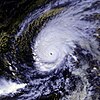Typhoon Paka (international designation: 9728, JTWC designation: 05C, PAGASA designation: Rubing, also known as Super Typhoon Paka) was the last tropical cyclone in the 1997 Pacific hurricane and typhoon season, and was among the strongest Pacific typhoons in the month of December. Paka, which is the Hawaiian name for Pat, developed on November 28 from a trough well to the southwest of Hawaii.
The storm tracked generally westward for much of its duration. On December 10 the cyclone attained typhoon status as it crossed the Marshall Islands. On December 16, Paka struck Guam and Rota with winds of 230 km/h (145 mph), and it strengthened further to reach peak winds on December 18 over open waters. Subsequently, it underwent a steady weakening trend, and on December 23 Paka dissipated.
Typhoon Paka first impacted the Marshall Islands, where it dropped heavy rainfall and left $80 million in damage (1997 USD). Later, it passed just north of Guam, where strong winds destroyed about 1,500 buildings and damaged 10,000 more, leaving 5,000 people homeless and causing a complete power outage. Damage on the island totaled $500 million (1997 USD). Paka also caused light damage in the Northern Mariana Islands. The typhoon caused no reported fatalities.
